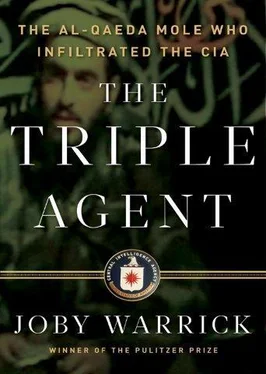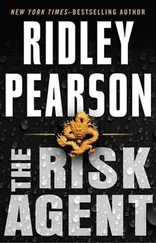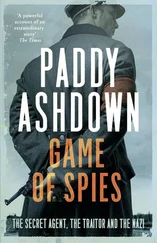The vest’s tight constraints and the positioning of the explosive pouches would channel the energy of the blast outward, toward whoever stood directly in front of him. Some of that energy wave would inevitably roll upward, ripping the bomber’s body apart at its weakest point, between the neck bones and lower jaw. It accounts for the curious phenomenon in which suicide bombers’ heads are severed clean at the moment of detonation and are later found in a state of perfect preservation several yards away from the torso’s shredded remains. When waves of suicide bombers attacked Israeli commuter buses and cafés during the Palestinian uprising in the early 2000s, police discovered that they could often distinguish the dead bomber from his victims by finding the corpse that was minus its head.
On this day a group of young Pakistani recruits, some of them tapped as future suicide bombers, gathered to admire the vest maker as he worked. One of them took photos with his cell phone as the man reached into his explosives chest and pulled out a surprise: not the usual bags of powder, but doughy sticks of a far more powerful military explosive called C4. He kneaded the sticks to flatten them and began to pack them into a row of thirteen fabric pouches he had sewn into the outside of the vest. Next he dipped a paintbrush into a bucket of industrial adhesive and slathered the white goo over a large square of sturdy cotton. The man then patiently studded the sheet with metal bits, piece by piece and row by row, alternating marble-size steel ball bearings with nails and scrap and, finally, some shiny twisted pieces that would have been recognizable to any American who happened to be in the room: children’s jacks.
Among the spectators, there had been lively discussions about the man who would likely wear the special vest. Most speculation centered on the young foreigner whom the recruits called Abu Leila, using the Arab practice of referring to adult men by the name of their oldest child and the word Abu, or “father of.” But Leila’s father wasn’t nearly so certain. When he left for Pakistan, Humam al-Balawi imagined himself a mujahideen, a holy warrior, fighting and maybe even dying in a righteous struggle against the enemies of God. What he hadn’t pictured for himself was a suicide vest. The one in the tailor’s shop in Datta Khel was still coming together, row after metal-studded row, but there was still time. In the coming days Balawi tried his best to make sure that the vest ended up belonging to someone else. Anyone but him.
Nothing had turned out as Balawi expected.
The death of Baitullah Mehsud had seemed like the end of the line and maybe the end of his life. The diminutive Mehsud had been Balawi’s host and principal defender when other Taliban leaders and even his own aides eyed the physician warily. Now that he was gone, the suspicions returned. Perhaps it had been the Jordanian who had directed the missiles against Taliban commanders, including Baitullah Mehsud himself.
Fortunately for Balawi, there were plenty of other possible suspects. Fifteen months of relentless Predator strikes had given rise to outlandish theories about how the CIA’s missiles found their targets with such precision. Much of the speculation centered on an “invisible ink” sprayed on automobiles with syringes or on mysterious microchips, called ghamay or “ring stones” by some Pakistanis, that served as homing beacons for missiles and could supposedly be hidden inside cigarettes or even disguised as ordinary stones. Many a tribesman had been executed by the Taliban on suspicion of planting the devices around the homes of prominent fighters.
But the search for spies was interrupted when Baitullah Mehsud’s followers began skirmishing over who would replace the dead Taliban leader. One of the disputes turned into a gun battle that very nearly killed Hakimullah Mehsud, Baitullah’s charismatic younger cousin and the presumed front-runner in the leadership contest. The wounded Hakimullah needed a doctor, and Balawi’s skills likely saved the young man’s life and perhaps his own.
Barely thirty, Hakimullah was tall and handsome, a shaggy Che Guevara to Baitullah’s diminutive Karl Marx, but the men shared the same impetuousness, and both took a liking to the Jordanian physician. Hakimullah had been affected deeply by his cousin’s death, and the moral obligation of badal , the Pashtun tribal tradition of blood vengeance, fell on his shoulders as the new chief. Balawi possessed useful abilities, apparently including the means to plant messages inside the CIA. Could he help avenge Baitullah’s death?
For the moment, Hakimullah decided, Balawi could use military training. The Mehsud clan ran training camps for jihadist recruits, and soon the doctor was on his way to a dusty camp in a North Waziristan village called Issori, with a few dozen other young men who aspired to fight for the Taliban.
Now Balawi’s days started at 5:30 A.M. and continued through the midday with calisthenics, target practice, and obstacle courses. In the afternoons the trainees studied bomb making, including the mechanics of suicide vests and roadside bombs. The group broke for meals and for mandatory daily prayers at the mosque and gathered in the evenings for discussions of theology and tactics. The local Pashtun youths in their teens and twenties who made up the bulk of the class eagerly welcomed the older Arab doctor who was said to be the famous essayist Abu Dujana al-Khorasani. But the camp’s physically taxing regimen showed up Balawi’s shortcomings in embarrassing ways. When the course ended, he still struggled with the basics of firing the AK-47 assault rifle, consistently allowing the barrel to jerk upward with the recoil so his shots flew well high of the target.
The worst moment occurred during a practice session for one of the Taliban’s favorite tactics, a vehicle ambush involving a pair of motorcycle assassins. Balawi had never driven a motorcycle, yet he found himself roaring along a dirt road, trying to simultaneously cling to the handlebars and to a weapon. Balawi lost control of his bike in the soft dirt and slammed into the second motorcycle, knocking both vehicles to the ground. Balawi felt a painful pop in his lower right leg and then the scrape of gravel against his face and arm as he skidded across the road. He lay still for a moment, mentally assessing the damage. The fibula bone in his left leg was broken.
The injury to his reputation, no doubt, was even worse. What good was a jihadist who had no aptitude for fighting?
Unbeknownst to Balawi, he had been watched and studied for months by men who saw potential in him. Finally, in the weeks after Baitullah Mehsud’s death, al-Qaeda made its move.
Balawi was invited to meet with a midlevel commander named Abdullah Said al-Libi, an operations chief for al-Qaeda in Pakistan. Soon afterward, the Libyan native made room for the physician in his compound, and Balawi moved in for a short stay. The Jordanian gradually was introduced to others within the small circle of al-Qaeda leaders in North Waziristan. Balawi drank tea with Atiyah Abd al-Rahman, the group’s religious adviser and diplomat. Finally he was introduced to the man who, for all practical purposes, was the chief tactical commander for all of al-Qaeda. In the leadership charts back in Langley, the man known as Sheikh Saeed al-Masri was ranked as the terrorist group’s No. 3. In reality, al-Masri called the shots while al-Qaeda’s top two communicated only rarely, through trusted messengers.
Al-Masri squinted at Balawi through a pair of narrow, oddly feminine glasses. The cagey old warrior was fifty-three but looked ancient, his long face weathered and deeply creased and his unkempt beard flecked with gray. On his forehead, just below his white turban, was a thumb-shaped bruise, a legacy of years of pressing his head against the floor during daily prayers.
Читать дальше












